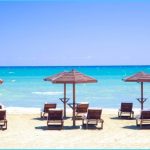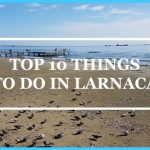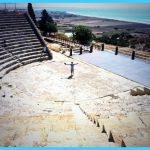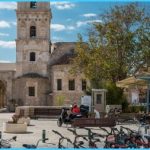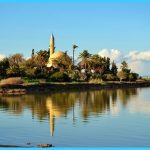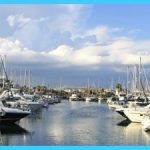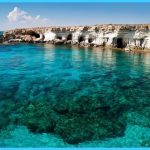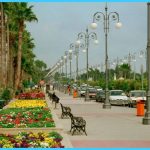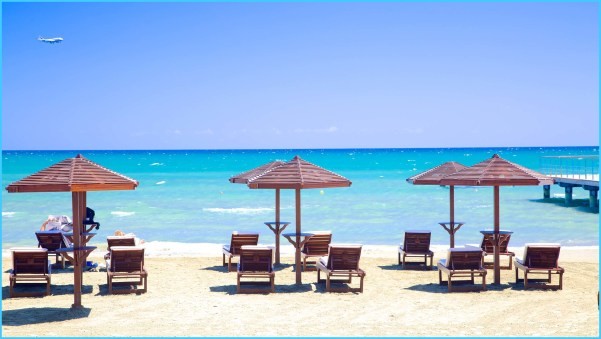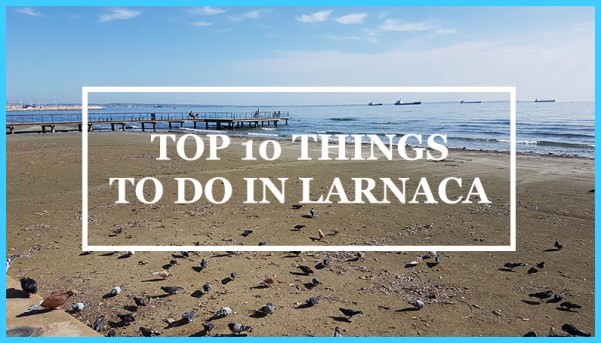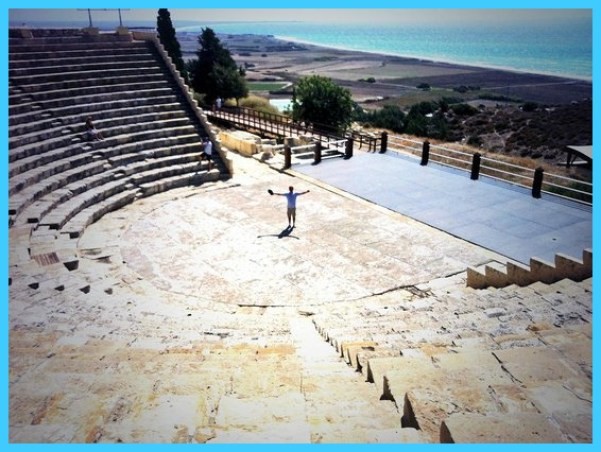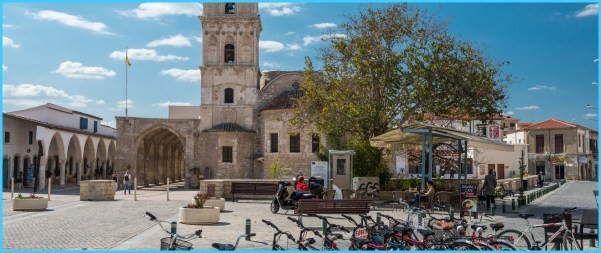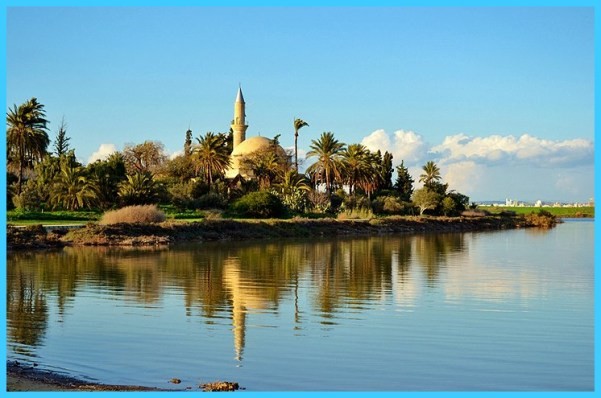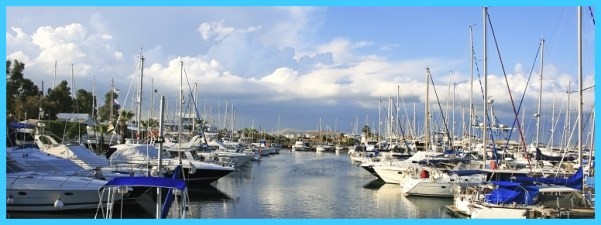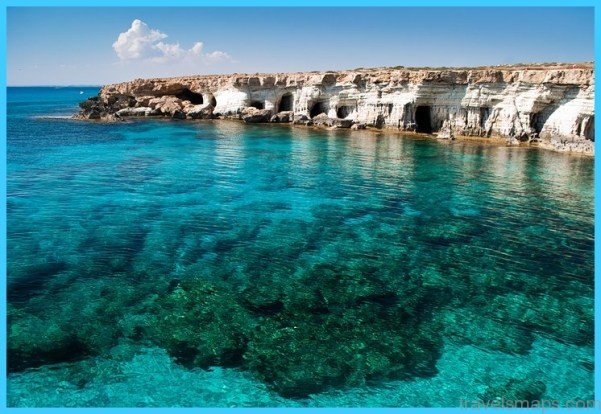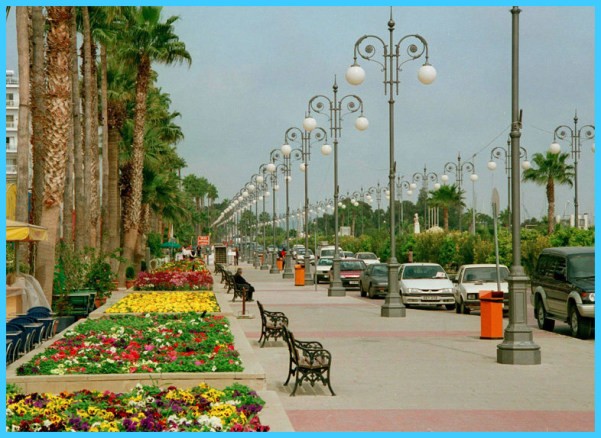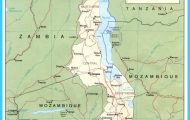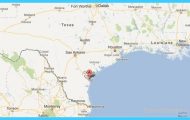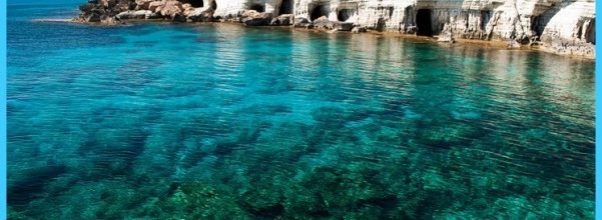
Larnaka Salt Lake
Makenzey beach
Festival of Kataklysmos. The festival of Kataklysmos is celebrated throughout Cyprus fifty days after the Orthodox Easter. From the previous evening children collect water in basins which they will pour, through different methods, on their friends or any passer-by. On Whit Monday, according to the custom, people, particularly in rural areas, pour water on each other from sunrise until sunset. Though this custom concerns children, elder ones take part as well. A specially devised pump from reeds, known as “pitsikla” is employed for the casting of water. Nobody complains that will get wet. In Larnaka, as well as in other coastal towns, the archbishop or the bishop, after the morning service, accompanied by the crowd, proceeds to the coast where he throws the Cross into the sea. Divers retrieve it. In Larnaka the celebrations usually last three days, starting on Saturday and ending late at night on Whit Monday. The festival has, however, great cultural significance, and during the three-day celebration contests from dancers, singers, and folk poets, particularly with their “tsiattismata”, take place. The village poets’ competition draws a large crowd of people who listen carefully to the verses which are very often satirical and cause laughter among the audience. Whit Monday is regarded as a day of purification, through water, not only for people but even for consecrated utensils, like the Cross which is thrown into the sea. The sea was considered by ancient Greeks as the best purifying means. The people who on Saturday (Psychosavvato) come into contact with the dead, ought to be cleaned and purified on Whit Monday. This is the explanation of the thousand year-old custom of the Cypriots, well illustrated in Larnaka.
EXPLORING THE EASTERN PART OF LARNAKA DISTRICT
Following the Larnaka-Dekeleia-Xylofagou road
Route: Coastal plain, Pyla, Dekeleia Xylotymvou, Ormideia, Xylofagou
Coastal Plain. The Larnaka beach appears as an arc bordered by colourful small pebbles. The plain around the sandy beach changed uses in the last few centuries. Sometimes cotton was cultivated, later the silk industry developed, while at another time the cultivation of cereals was a monoculture. Nowdays the Larnaka plain is undergoing an unprecedented tourist activity. Numerous hotels and various other tourist installations have sprung up in the coastal plain. Two fishing shelters, that of Ormideia, quite picturesque, and another makeshift in Xylofagou lend, with their fishing boats, colour to this coastal area.
Larnaca Travel Guide and Tourist Information: Larnaca, Cyprus
Sunbathing after swimming
Pyla, in the north of Larnaka bay, is the only village in the free part of Cyprus where Greek and Turkish-Cypriots live together. Pyla’s roots are extremely ancient, since archaeological excavations have revealed quite a few archaeological findings, which bespeak the brilliant history of this mixed village. Archaeological excavations at Kokkino-kremos, Steno, Vergi and Koukkoufouthkia, have proved that the area used to be densely populated during the Late Bronze Age. Besides, the Pyla tomb belongs to the classical times. Inscriptions that have been discovered at Pyla testify that here existed a temple dedicated to Apollo. Especially at Kokkinokremos, on a hill that dominates Larnaka bay, a building has been unearthed used both as a store and as a defense site. Moreover, installations for the local treatment of copper, silver and gold in the 13th century B.C were discovered here. From the medieval buildings the Pyla tower has remained intact, even if the floor and the roofs of this three-storeyed building have not survived. The tower had a hanging bridge or a wooden ladder that used to link the first floor with the rest of the building. Pyla, Xylofagou, Alaminos and Kiti towers comprise a chain of towers along Larnaka bay and even further up, which acted as observatories.
Pyla Tower
Dekeleia, a British Sovereign Base, is situated in the eastern part of Larnaka bay, close to Dekeleia Power station. A beautiful beach close to restaurants and other facilities, is exclusively used by the families of the British army. Xylotymvou, a populous village of the Kokkinochoria region, is the village of many churches. In addition, a spectacular show of parachutists is a daily phenomenon since nearby, at a site belonging to the British Bases, continuous training of parachutists takes place. Near the center of the village stands the painted church of Agioi Andronikos and Athanasia. It is a contemporary building, erected on the foundations of an older church. The contemporary and elegant chapel of Agios Ionas was built in 1984. Very close to it is the domed chapel of Agios Vasilios with traces of frescoes. The domed chapel dedicated to Agia Marina lies nearby. This 15th century chapel was used as a focus for the construction, in 1992, of a quadrilateral, high-walled monastery dedicated to Agia Marina and Agios Rafail. As the visitor can ascertain, the church of Agia Marina was, at one time, frescoed but a number of fires and whitewashing have destroyed the original paintings. The church of Agios Rafail was built and decorated with a number of different icons, some of which refer to the martyrdom of the saint himself as well as to the torment suffered by Agios Nikolaos and Agia Eirini. In 1992, the remains of Agios Rafail, encased in a silver casket, were brought over from the Greek island of Mytilini (Lesvos), an event which was hailed reverently by the Christian population of Cyprus.
Top-Rated Tourist Attractions in Larnaca
Citrus growing at Ormideia
Ormideia is a well known village belonging to the Kokkinochoria region. As it is well known, in the 18th century and until the beginning of the 19th century, there used to be some villas in the village, belonging to consuls and merchants, mainly used during the summer months. Ormideia does not lack in cultural heritage. According to Leontios Machairas, Agios Konstantinos the Soldier lived here. A chapel has been recenlty built on the place where he led an ascetic life. Towards the bottom of the rock the original hermitage of the saint is to be found. The inhabitants of Ormideia call the cave a “sacred cave”, while some of them remember the holy water in the valley opposite. Besides, the church of Agios Georgios Angonas is another remarkable monument at the village, since it is, according to Gunnis, a 14th century building. It is found about 2km outside the village and it may be the only surviving edifice belonging to the ancient settlement in the area. It has a dome, and is of a cruciform architectural style with a vaulted section on one side. The traces of frescoes attest that the church used to be completely covered with paintings. The church iconostasis is gilted with rich reliefs. In the fishing shelter of Ormideia about twenty colourful fishing boats are moored opposite the breakwater. The traveller who passes by the picturesque and colourful Ormideia fishing shelter feels that he has to stop, refresh himself, rest and enjoy the scenery.
Parachutist near Xylotymvou
Xylofagou. The spectacle that appears before your eyes as you travel through Xylofagou, is the ceaseless agricultural activity, the fully mechanized farming and the dark-green colour of the potato plants next to the deep red colour of the uncultivated soil. The domed church of Agios Georgios, near the center of the village, next to a new church, is possibly a 16th century edifice. Another medieval cultural monument is the Venetian tower to the south-east of the village. It overlooks cape Pyla, between Larnaka and Cape Gkreko. The tower, at an elevation of about 100 metres a.s.l., can be seen from afar. The tower is circular, about six metres in diameter and five metres tall. Also in Xylofagou, in a vertical cliff on the sea, east of cape Pyla, there is a labyrinthine cave, known as “The Cave of the Forty MartyrsThe cliff which houses the cave is about 40 metres high and the entrance to the cave is about 12 metres above sea level. Any attempt to enter the cave is considered very dangerous and a visit to the cave is definitely not recommended. On the floor of the cave, however, one comes across fossilized bones and it is still not clear if they are human or belong to animals long extinct. According to tradition it is here that 40 martyrs of Orthodoxy lived and were buried, either using the cave as a catacomb during the early years of Christianity or as a refuge during the dark ages of Ottoman occupation of the island.
Visit to Agios Antonios Church (Kellia) & Troulloi mines.
Route: Livadia, Kellia, Voroklini, Troulloi, Avdellero
In Livadia, the traditional craftsmanship of basket-weaving is continuing, although very few baskets are being made. It is very surprising how more than ninety families still continue together with other occupations, to make straw mats. The medieval church of Agia Paraskevi is a cultural monument worth noticing. The coat of arms above the western door cannot be seen any longer. However, the old church icons, such as that of Agia Paraskevi (1735) and those of Christ and the Virgin Mary surrounded by Saints (around 1740) are still present and continue to impress. The church of Agios Antonios deserves a special visit to Kellia. On a gentle hill lies the church of Agios Antonios with a double narthex. Originally the church, which probably dates back to the 9th century A.D., was cross-shaped and domed. The passing of time, natural deterioration and especially the attack of the Mamelukes, who arrived in Cyprus in 1424, destroyed the church, a fact that has contributed to its abandonment for many years. It was reconstructed in 1500 and received numerous modifications, that have changed the architecture of the three-aisled building. Nowadays the visitor will distinguish neither the dome nor the skylights, while the frescoes, which originally covered the entire church, are limited in number. The iconostasis, a 17th century creation, no longer exists. The frescoes which have survived date back to the 9th and the 13th centuries. It is quite certain that a more ancient church existed on the foundation of the present church, since the name of the village suggests the existence of an old monastery. Some interesting paintings to be observed are: the Sacrifice of Isaac, an early 11th c painting on the south-west pier, St. Demetrius, holding a spear with his right hand and a large shield with his left on the south-west central pier, St. George mounted and two female saints below, on the north-west central pier, the enthroned Virgin Mary holding the Child Christ in her lap opposite the Sacrifice of Isaac, and the remnants of an early Crucifixion in an archaic style and iconography of the Eastern character on the west side of the south-east pier. Voroklini. Somewhere in the middle of Larnaka tourist beach a road leads to Voroklini, found between Livadia and Pyla. At the village entrance is the “Voroklini lake”, which fills with water, at times of heavy rainfall. The Voroklini community and the Development Bank have signed an agreement for the exploitation of 96 hectares of land in the lake in order to create a modern park as well as various places of entertainment. The Voroklini settlement is built at the base of an elevation, known as Yerakomoutti, at the summit of which stands the chapel of Profitis Ilias, previously known as the monastery of Profitis Ilias. Here the dragoman of Cyprus, Hadjigeorgakis Kornesios, found refuge in 1809, while waiting for a boat to take him to Constantinople, in order to be saved from the persecution of the Turks.
Lotus cultivation at the monastery of Metamorfosis
Troulloi. The village of Troulloi, situated in the north-east of Larnaka, part of which is under Turkish occupation, is better known for its mines and its quarry of umber than for its agriculture. It seems that the extraction of ore began quite early, in the pre-Christian era, a fact indicating that Troulloi was inhabited early. Beyond the exploitation of copper in recent years, gold has also been exploited at Troulloi. It is known that between 1935 and 1939 many tons of gold-bearing ore were extracted and many kilos of gold and silver were produced. Today the copper bearing ore is not exploited, because the Troulloi mine is situated in the buffer zone. The exploitation of umber is, however, being proccessed in the village, not from earth taken within the village boundaries, but from material transported from many parts of Cyprus. The church of Agios Mamas, which was built in the 16th century, possesses an ancient iconostasis and several very old and remarkable icons, like that of Archangelos Michail dated 1580, the Virgin Mary, probably dated 1500 and of Agios Mamas dated 1708. The old monastery of Agios Georgios Mavros is not known when exactly was founded. According to some authors, it might have existed since the Byzantine period. It possibly stopped existing around 1850. Apart from the church of Agios Georgios, which was renovated in 1722, in the premises of the old monastery today only the olive press and a number of marble columns and pillars survive. The monastery of Ag.Georgios of Mavrovouni is currently functioning with a few monks. Avdellero. Within the village administrative boundaries one finds the Monastery of Archangelos Michail, now abandoned. The contemporary monastery of the followers of the old calendar hosts 22 nuns of all ages, and is known as the Monastery of Metamorfosis. The monastery was completed in 1984 and has succeeded an older one situated next to it, that of Agios Modestos, founded in 1948. The nuns occupy themselves mainly with farming and especially gardening. A great variety of fruit are cultivated within the monastery grounds, such as dates, lotus, papaya, etc.
Best Things to Do in Larnaca Photo Gallery
Athienou via Aradippou Route: Aradippou, Kosi, Athienou, Petrofani
Aradippou, is a densely populated settlement, about 6km north-west of Larnaka. Quite a few industrial units function in this village, since the Larnaka main industrial area is situated within the village’s administrative boundaries. The church of Saint Luke stands in the center of the village. According to an inscription at the entrance, it was built in 1700, renovated in 1871 and extended in 1939. It is three-aisled, with a gilted iconostasis and pulpit. The church is partially covered with impressive frescoes, even though they are recent. The church of Panagia Ematousa or of the Vineyards is situated in the northwest of the village. It seems to have been constructed on the foundations of an older church. Outside the church, close to the western entrance, there is a big, rectangular rock. According to tradition, whoever suffers from severe haemorrhage and sits on this rock, will be cured. According to Mas Latrie, “the Lusignans had a residence in Aradippou… and king Hugo IV lived there between 1352 and 1354”. Besides, Jeffery writes about Aradippou: “It was burnt down by the Saracens in 1425. It seems that there used to be an important mansion in the 14th century”. Archaeological excavations unearthed significant findings as well as the existence of an ancient settlement, around the church of Ematousa, which goes back to the 7th century B.C.
Limestone statue, Petrofani (Photo, courtesy of the Dept. of Antiquities)
The excavations are still going on. Kosi is currently abandoned. Athienou though in the free part of Cyprus, is surrounded by Turkish troops. The area abounds in sheds for fodder, as well as modern animal raising installations. In 1982 Athienou was the first village in Cyprus not only in the variety of industries but also on the number of industrial units. Once you find yourself in the village, you have to taste yoghurt, halloumi, peanuts, which are treated in a special way, and of course, you have to try
Athienou bread. About ten ovens, modern and fully automatic, make bread continuously, sometimes on a 24-hour basis, sending their products to almost all towns and villages of Cyprus. The village in the past was known for the cart-driver’s profession, as mentioned by several authors. Somewhere in the center of the village an inn has survived. Petrofani is currently abandoned. Very close to Petrofani and Athienou, at a place called Malloura, there is an archaeological site where Hamilton Lang carried out excavations. The 1992 excavations unearthed remnants of the late Roman period as well as of the Frankish period. Recent excavations have brought to light the head of Apollo who was worshipped at Malloura.
Maybe You Like Them Too
- The Best Places To Visit In North America For Christmas
- Faro Travel Guide: Map of Faro
- Mumbai Travel Guide For Tourists: Map Of Mumbai
- Travel to Budapest
- Thailand Travel Guide for Tourists: The Ultimate Thailand Map

